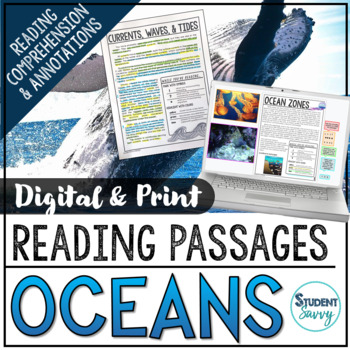Ocean Reading Comprehension Passages Oceanography Ocean Zones Waves & Tides
- Zip
What educators are saying
Also included in
- Earth Science Curriculum | Environmental Science {Both DIGITAL & PRINT}NGSS (NEXT GENERATION SCIENCE STANDARDS) and COMMON CORE ALIGNED!UPDATE: OCEANOLOGY, SPACE & SOLAR SYSTEM Resources are now included!Unit topics include: Rock Cycle, Rocks & Minerals, Plate Tectonics, Ecosystems, BioPrice $298.35Original Price $331.50Save $33.15
- ALL of the Reading Comprehension Passages in the StudentSavvy Store! Nonfiction **CURRENTLY 273 Passages!**-Worksheets - Reading Comprehension Passages, Questions, and Annotations--Both Print (PDF) & Digital Options (either in Google Slides or Easel by TpT) It contains Engaging, Non-Fiction ReadPrice $195.00Original Price $302.21Save $107.21
- Ocean and Continents Resource BundleThis bundled product contains the following 6 Ocean resources!Reading PassagesInteractive NotebookInteractive PowerPointSTEM ChallengesGoogle Classroom Student ProjectsAssessmentsAll you'll ever need for a complete Ocean Unit!Aligned with Earth Science Complete CuPrice $22.78Original Price $28.48Save $5.70
Description
Ocean Worksheets - Reading Comprehension Passages, Questions, and Annotations
This resource is designed for an Ocean unit. It contains 5 Engaging, Non-Fiction Reading Comprehension Passages with Directions for Student Annotations! Reading Comprehension Questions also included!
Questions & Answer Keys for Each of the 5 Reading Passages!
COMMON CORE ALIGNED!
Aligned with Earth Science Complete Curriculum
Quick overview of topics covered in this resource include:
1. Waves, Tides, and Currents
Overview of ocean movement - waves, tides, and currents
Waves – caused by wind. (wind speed, wind time, and wind distance)
Tides are large waves that move in response to forces exerted by the Sun and Moon. Tides move water up and down.
Currents move water in a back and forth motion. Continuous, directed movement of water.
Surface currents are caused by solar heating and wind.
Deep water currents are caused from interactive of water density and temperature.
2. The 5 Oceans
Overview and description of each of the 5 oceans – Pacific Ocean, Atlantic Ocean, Arctic Ocean, and Southern (Antarctic) Ocean
Facts for each ocean should include – location, size, depth, salinity, water temperature, ecosystems (plants & animals),
Vocabulary: Pacific Ocean, Atlantic Ocean, Indian Ocean, Artic Ocean, Southern (Antarctic) Ocean
3. Ocean Zones
Overview of how the ocean is divided into five zones (epipelagic zone {sunlight zone}, mesopelagic zone {twilight zone}, bathypelagic zone {midnight zone}, abyssopelagic zone {the abyss}, hadopelagic zone {the trenches})
-description of each ocean zone in order from surface to deepest point. Description of temperature, water pressure, and plants and animals.
4. Marine Ecology – Plants and Animals of the Sea
Overview of marine ecology (the study of ocean life, such as habitat, populations, and interactions with organisms and environment) -definition of biotic (living) and abiotic (nonliving) factors in marine ecosystems
-Overview of marine different marine ecosystems – salt marshes, mangrove forests, coral reefs, open ocean, deep-sea, and estuaries. (important biotic factors (plants and animals) and abiotic factors of each type)
Vocabulary: Marine Ecology, biotic factors, abiotic factors, salt marshes, mangrove forests, coral reefs, open ocean, deep sea, estuaries
5. Protecting Our Oceans
-Overview of importance and why we should keep our oceans clean (important part of Earth’s ecosystem – source of food, life, and biodiversity. Source of renewable energy, regulates our climate, affects our health and well-being ) Life would not exist without our oceans.
-Overexploitation of our oceans, overfishing endangers ocean ecosystems and a food crisis.
Various ways to protect oceans – reduce plastic usage, conserve water, clean up beaches after use, recycle at home, respect habitats, reduce pollutants and choose nontoxic chemicals, using fuel efficient vehicles,
Vocabulary: pollution, preservation, ocean conservation, reusable, biodiversity, overexploitation
You may also enjoy:
Earth Science Interactive Notebooks
Rock Cycle Interactive Notebook
Rocks, Minerals, and Gems Interactive Notebook
Plate Tectonics Interactive Notebook
__________________________________________________________________
Tips for Savvy TpT Shoppers:
How to receive credit on TpT to use for future purchases:
• Go to your My Purchases page. Under each purchase you'll see a Provide Feedback button. Simply click it and you will be taken to a page where you can give a quick rating and leave a short comment for the product. I value your feedback greatly as it helps me determine which products are most valuable for your classroom so I can create more for you.
Be the first to know about my new discounts, FREEBIES, and products:
• Look for a green star near the top of any page within my store and click it to become a follower. You will now be able to see FREEBIES and customized emails from my store!
©2019StudentSavvy
All rights reserved by author. Permission to copy for single classroom use only. Electronic distribution limited to single classroom use only. (unless you purchase the multiple license)
____________________________________________________________








